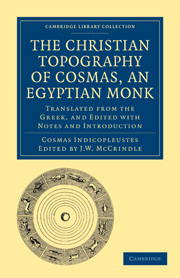 The Christian Topography of Cosmas, an Egyptian Monk
The Christian Topography of Cosmas, an Egyptian Monk BOOK XI
Published online by Cambridge University Press: 10 November 2010
Summary
A description of Indian Animals, and of the Island of Taprobane.
This animal is called the rhinoceros from having horns upon his snout. When he is walking his horns are mobile, but when he sees anything to move his rage, he erects them and they become so rigid that they are strong enough to tear up even trees by the root, those especially which come right before him. His eyes are placed low down near his jaws. He is altogether a fearful animal, and he is somehow hostile to the elephant. His feet and his skin, however, closely resemble those of the elephant. His skin, when dried, is four fingers thick, and this some people put, instead of iron, in the plough, and with it plough the land. The Ethiopians in their own dialect call the rhinoceros Arou, or Harisi, aspirating the alpha of the latter word, and adding risi. By the arou they designate the beast as such, and by arisi, ploughing, giving him this name from his shape about the nostrils, and also from the use to which his hide is turned. In Ethiopia I once saw a live rhinoceros while I was standing at a far distance, and I saw also the skin of a dead one stuffed with chaff, standing in the royal palace, and so I have been able to draw him accurately.
- Type
- Chapter
- Information
- The Christian Topography of Cosmas, an Egyptian MonkTranslated from the Greek, and Edited with Notes and Introduction, pp. 358 - 373Publisher: Cambridge University PressPrint publication year: 2010First published in: 1897
